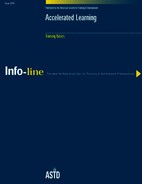Review and Application
No matter how quickly learning takes place, the real test is applying that knowledge in the workplace. Review materials might include visualizing how the new knowledge or skill can be applied on the job, developing an action plan of steps to be taken once the learner has returned to the workplace, or developing a network of learners who are interested in meeting periodically to encourage ongoing mutual support and collaboration. Whatever method is used, the review should consolidate the learning in the participant's mind.
Accelerated Learning Course SampleThe following shows a course outline for teaching the principles of accelerated learning (AL). It is an example of how accelerated learning techniques can be employed. Within the four phases, the creativity of the trainer can express a unique combination of these techniques. Preparation Positive suggestion “You will find it easy to learn these principles and techniques for enhancing your training programs” is an example of a positive suggestion. Multisensory environment Trainers can add the following items to create a multisensory environment:
Learner-benefit statements You will create more effective training programs and enable learners to have more fun during training if you develop a learner-benefit statement. Warm-up and introductions Use icebreakers to put participants at ease and involve them in their own learning. Presentation Overview Use a mind map to outline session. Assessment Pretest AL principles and techniques. Lecture Describe AL principles, models, and techniques. Use transparencies to present and illustrate concepts. Metaphor/prop Use metaphors to describe abstract concepts, such as using the conventional/microwave oven image for industrial versus information model. Imagery Present a story of excellent training: Have the learners visualize applying AL ideas to job situations. Music Do an energizer stretch. Practice Activity Groups design an AL session, selecting from props, music, posters, and techniques. Demonstrate Groups share their design with class. Review and Apply Concert review Show content transparencies with music. Application Do an action planning sheet. Share. Set up a network for mutual support and collaboration.
|
Many trainers have had success with an approach called “concert review.” Concert reviews involve playing music while course material is reviewed to strengthen learning and stimulate recognition (mental practice). The material is presented in an auditory and or visual format. When presented auditorially, the material is read in rhythm with the music. When presented visually, music accompanies a visual display of previously viewed material, such as transparencies, flipcharts, and mind maps. Videos can be used to review demonstrations, practices, or exercises in which the learners participated. Personal reviews peak interest and recall.
Looking to the Future
Accelerated learning provides a tool for addressing the future needs of the workforce. It is a training approach that integrates a number of proven methodologies in which trainers and participants alike develop creative insights into the learning process by exploring and experimenting with new ideas. Through accelerated learning, trainees are encouraged to accept the challenge of the continuous learning that will be required of them in a rapidly changing work environment.
Music as a Learning AcceleratorSelect the pace of music according to the atmosphere you want to create: relaxing, energizing, inspiring, or reflective. For example, play:
Music Suggestions
|
Mind MapsMind maps are creative diagrams of connected ideas. Developed in the mid-1950s, they were popularized by Tony Buzan and Evelyn Wood. Mind maps illustrate network displays that correspond to the brain's processing/storage mechanisms. As such, they tap both visual and verbal functions of the brain resulting in better integration and retention and can generate new insights and connections between ideas. Mind maps stimulate creativity and comprehension. An example of a mind map is shown below. How to Create a Mind Map
|


